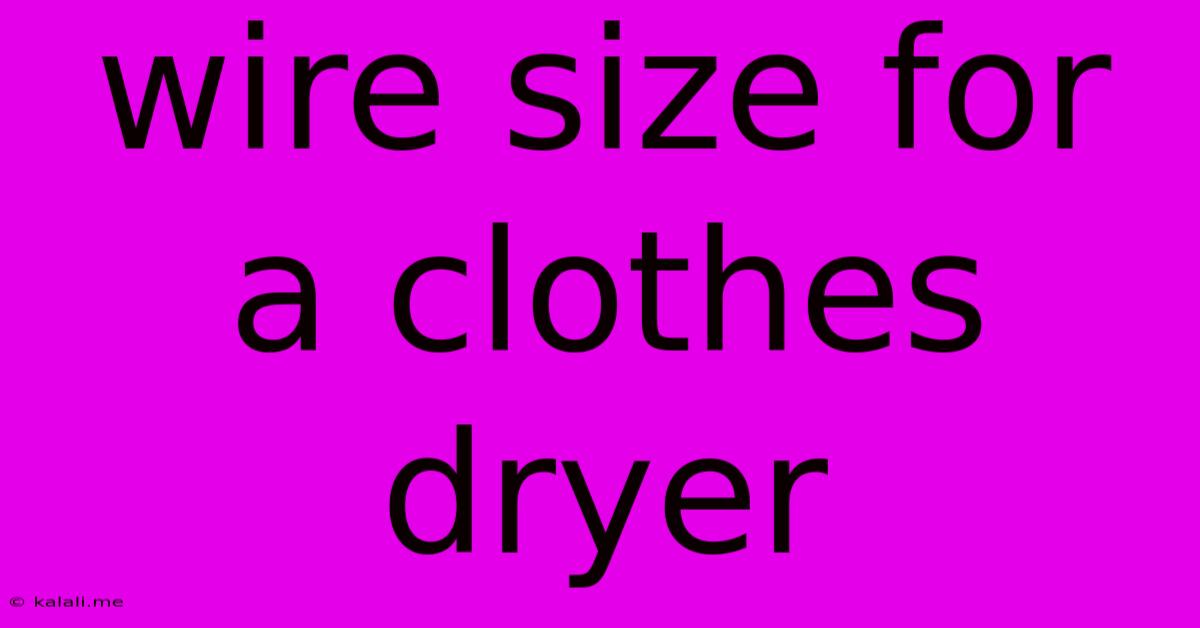Wire Size For A Clothes Dryer
Kalali
Jun 01, 2025 · 3 min read

Table of Contents
Choosing the Right Wire Size for Your Clothes Dryer: A Comprehensive Guide
Meta Description: Learn how to determine the correct wire size for your clothes dryer installation, ensuring safety and optimal performance. This guide covers amperage, voltage, and wire gauge calculations for a safe and efficient connection.
Installing a clothes dryer requires careful attention to electrical safety. One crucial aspect often overlooked is selecting the appropriate wire size. Using the wrong gauge wire can lead to overheating, potential fire hazards, and even damage to your appliance. This guide will walk you through understanding the factors that influence wire size selection for your dryer installation.
Understanding Amperage and Voltage
Before we delve into wire gauges, let's clarify the fundamentals: amperage and voltage. Your dryer's nameplate (usually located on the back or inside the door) will specify these crucial parameters.
- Amperage (Amps): This indicates the amount of electrical current your dryer draws. Higher amperage means more power consumption.
- Voltage (Volts): This specifies the electrical pressure pushing the current through the appliance. Dryers commonly operate on either 120V or 240V.
These two values are essential for calculating the appropriate wire size. A higher amperage typically requires a thicker (lower gauge number) wire to handle the increased current flow.
Calculating Wire Gauge Based on Amperage and Distance
The National Electrical Code (NEC) provides guidelines for safe wire sizing. However, precise calculations require considering several factors beyond just amperage:
- Amperage rating of the dryer: This is the most critical factor.
- Distance from the electrical panel to the dryer: Longer runs require thicker wire to compensate for voltage drop.
- Type of wire: Different wire types (e.g., copper, aluminum) have varying current-carrying capacities. Copper is generally preferred for its superior conductivity.
- Ambient temperature: High temperatures can affect wire capacity.
You should consult a qualified electrician for precise calculations, especially for longer runs or complex wiring situations. They can accurately determine the appropriate wire gauge based on the specific conditions of your installation.
Common Wire Gauges for Dryers
While precise calculations are necessary, here's a general guideline based on common dryer amperages:
- Dryers operating at 15 amps: Typically use 14 AWG (American Wire Gauge) wire.
- Dryers operating at 20 amps: Typically use 12 AWG wire.
- Dryers operating at 30 amps or higher: Typically use 10 AWG or 8 AWG wire.
Remember, these are general guidelines and may not be suitable for all installations. Always refer to your dryer's nameplate and consult a qualified electrician to confirm the correct wire size for your specific needs.
Safety Precautions
- Never attempt electrical work if you are not qualified. Incorrect wiring can lead to serious injury or fire.
- Always turn off the power at the breaker box before working with electrical wiring.
- Inspect the wiring for any damage before use. Replace any damaged or frayed wires immediately.
- Ensure all connections are secure and properly insulated.
Choosing the correct wire size is crucial for the safe and efficient operation of your clothes dryer. By understanding the factors influencing wire selection and consulting a qualified electrician when necessary, you can ensure a safe and reliable installation. Remember to prioritize safety and consult a professional when in doubt. This will guarantee a worry-free laundry experience for years to come.
Latest Posts
Latest Posts
-
One Punch Man Webcomic Vs Manga
Jun 03, 2025
-
Tar Error Opening Archive Unrecognized Archive Format
Jun 03, 2025
-
How To Get Gorilla Glue Off Wood
Jun 03, 2025
-
You Have The Watches We Have The Time
Jun 03, 2025
-
Cant Connect To Local Mysql Server Through Socket Tmp Mysql Sock 2
Jun 03, 2025
Related Post
Thank you for visiting our website which covers about Wire Size For A Clothes Dryer . We hope the information provided has been useful to you. Feel free to contact us if you have any questions or need further assistance. See you next time and don't miss to bookmark.